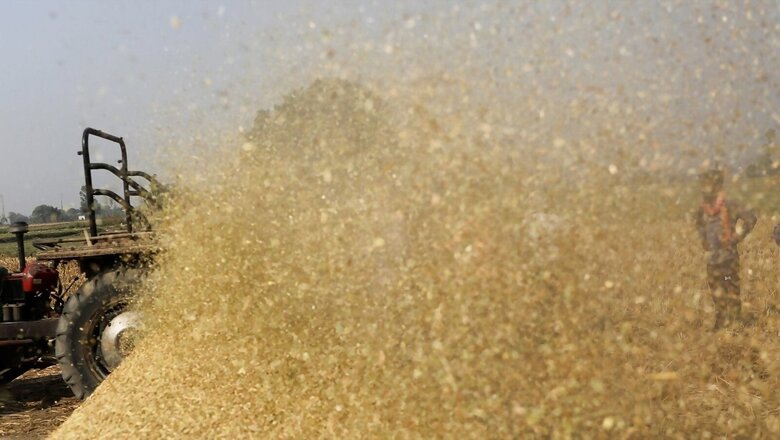
views
The Union Cabinet on Thursday approved a proposal to distribute fortified rice via different government schemes in a bid to fight the menace of malnutrition and nutritional deficiency in the country, sources said. The government is likely to spend about Rs 2,700 crore per year on the scheme. The decision came at a late evening meeting of the Cabinet Committee on Economic Affairs (CCEA), sources added.
At present, of the 15 states identified for the scheme on fortified rice and its disbursal via the public distribution system, five states – Andhra Pradesh, Gujarat, Maharashtra, Tamil Nadu and Chhattisgarh – are implementing it in one district each on a pilot basis.
The scheme was first announced by Prime Minister Narendra Modi during his last year’s Independence Day speech where he pledged that by 2024, all rice distributed by the government will be fortified with nutrients.
What is fortification and how it’s done?
It is a process through which vital micronutrients in food are added to boost its nutritional value. Fortification seeks to add the vitamins and minerals in rice that may be lost during the milling and polishing process.
For producing fortified rice, micronutrients like iron, folic acid, and Vitamin B12 are mixed with rice flour. The fortified rice kernels are produced from this mixture using an extruder machine, which is like pasta-making equipment. This fortified rice resembles “milled rice in size, shape, and colour but contains additional vitamins and minerals that retain their micronutrient content when washed and boiled in water”.
“When these kernels are blended with non-fortified rice, typically at a ratio of 1:100, the result is fortified rice that is nearly identical to non-fortified rice in aroma, taste, and texture,” the Consumer Affairs Ministry’s Department of Food and Public Distribution (DFPD) has said.
Apart from the minerals already mentioned, fortified rice may also include zinc, vitamin A, vitamin B1, vitamin B2, etc. “as optional micronutrients”.
WHAT IS ‘HIDDEN HUNGER’?
Eating one’s full may not always be tantamount to eating healthy, and the issue is not limited to junk food. Globally, diets deficient in vitamins and minerals affect more than 2 billion people and India has an especially high burden of such people, being “home to about 60 per cent of anaemic preschool children, 50 per cent of anaemic pregnant women, and a quarter of anaemic men”.
Since a deficit of nutrients is not a conspicuous lack, the problem may “often go unnoticed”. That is the reason why it is also termed ‘hidden hunger’. But though it may be hard to detect, its ramifications can be serious: “Around the world, pregnant women and children under 5 years of age are at the highest risk of micronutrient deficiencies which contribute towards poor growth, intellectual impairment, prenatal complications, and increased risk of morbidity and mortality,” the Centre has said.
Why rice fortification to fight malnutrition?
“Milled rice generally is low in micronutrient content because its nutrient-rich superficial layer is removed during rice milling and polishing operations. This makes the grain taste better and visually appealing but less nutritious,” the Centre has found.
With a view to addressing the issue of malnutrition, the DFPD launched a three-year pilot programme for the fortification of rice and its distribution through the Public Distribution System (PDS) in 2019-2020.
Given that rice tops the distribution tally for government safety-net programmes such as the PDS, Mid-Day Meal (MDM), Integrated Child Development Services (ICDS), which have “the potential to reach 800 million vulnerable people in India, especially women and children”, food fortification has been made a key part of the National Nutrition Mission (Poshan Abhiyan), which was launched in 2018.
Ecosystem required for rice fortification
A release from the Consumer Affairs Ministry last November had said that the availability of fortified rice kernels was at “a meagre quantity of 15,000 metric tonnes (MT) per annum”. It had noted that to cover 112 Aspirational Districts for PDS, ICDS and MDM would mean a “requirement of nearly 130 lakh MT of fortified rice”.
“ If the entire PDS rice supply which is of the order of about 350 lakh MT is to be fortified, then there has to be an uninterrupted supply pipeline of [fortified rice] from the industry of the order of about 3.5 lakh MT,” the ministry had said.
For this, nearly 28,000 rice mills in the country “need to be equipped with blending machines etc.” for producing fortified rice, it had added. Noting the efficacy of rice fortification in countering malnutrition, the ministry said that multiple studies have shown the “efficacy and effectiveness of fortified rice in improving micronutrient status” through the reduction in anaemia and improved iron and vitamin levels. “One study reported a significant improvement in the physical endurance of the children who consumed high iron-fortified rice for 6 months,” it said.
Read all the Latest News India and Breaking News here


















Comments
0 comment